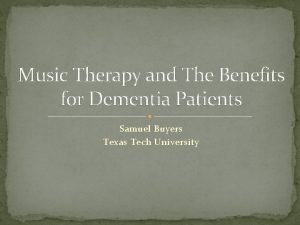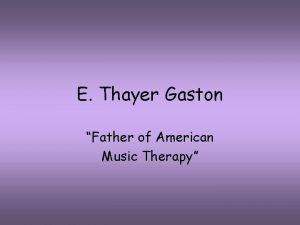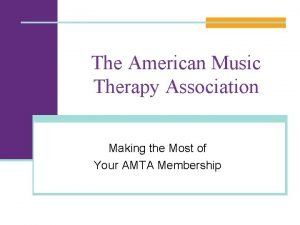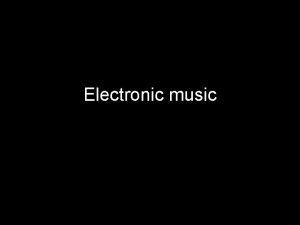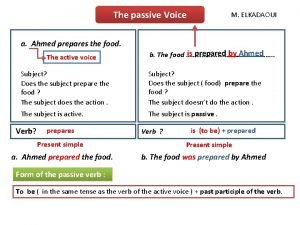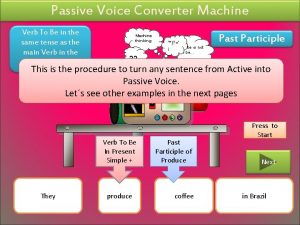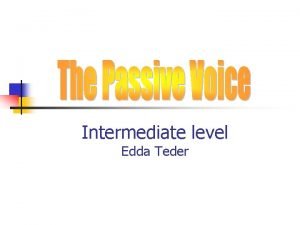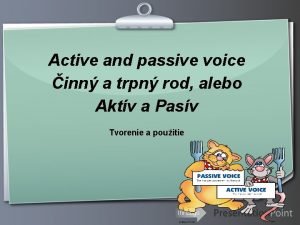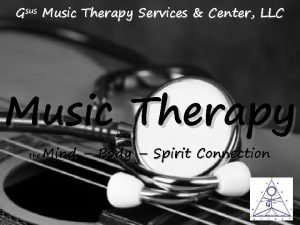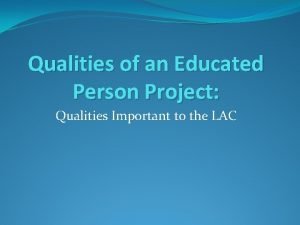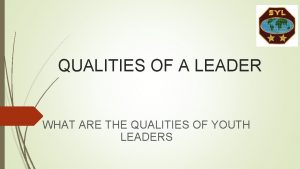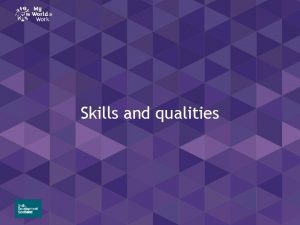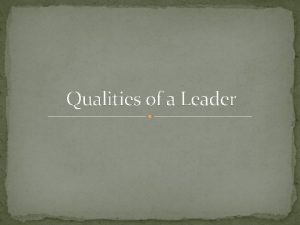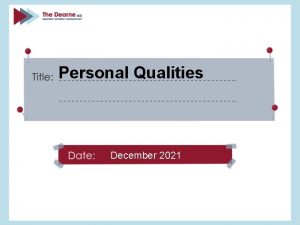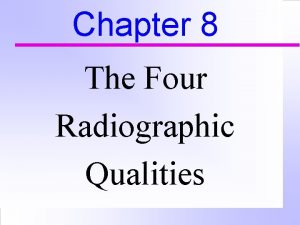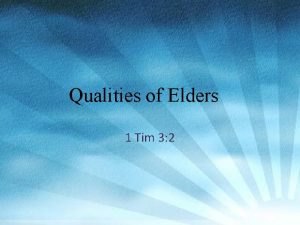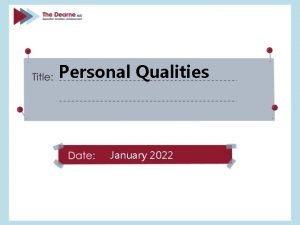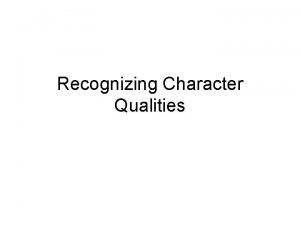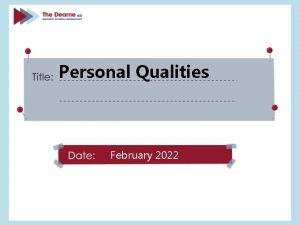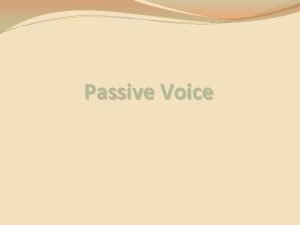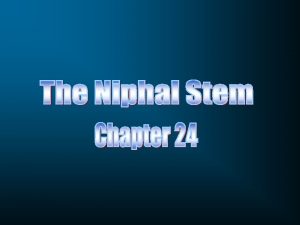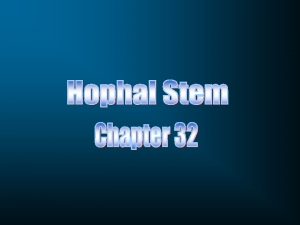The Application of Voice Qualities in Music Therapy

























- Slides: 25

The Application of Voice Qualities in Music Therapy Joanne Beck, MA, CMT, NMT

Vocal Matching What we choose and how we deliver music is dependent upon patient emotional, physical state Our voices are essential. 38% of our language comprehension comes from TONE. Singing and Speaking (music and language) are two distinctly human abilities.

Music Therapy Goal Music therapists, through the vehicle of sound and music provide an aural reflection of the expressive needs of our patients.

Instrumental What would a translation of the following experiences sound like when placed into music? : Of Joy? Of Pain? Of Depression/Sadness? Of Anger?

Voice What would a translation of the following experiences sound like using your voice? Of Joy? Of Pain? Of Depression/Sadness Of Anger?

Mirror Neurons When we, as trained music therapists access our cerebral empathy centers, we are better able to translate through our voices and our instruments, the present experience/consciousness of our patients.

What We as Music Therapists do…….

How do we Do this? http: //www. ted. com/talks/vs_ramachandran_the_neurons_t hat_shaped_civilization Developing our empathy centers. Observing through multi-sensory systems, we process through empathy pathways multisensory information about the state of the other person. Monkeys have mirror neurons, yet we do not work long and hard enough on the human development of empathy.

What about the. Voice? How do we use our voices as instruments of reflection? How do we sing with an angry sound, sad, aggressive, without hurting our voices? What if one client requires live classical and another requires Broadway belting? Do we still sing like Joan Baez? (NO!)

Our Beautiful Structure

Power-Source-Filter Power: Lungs and torso: BREATH: draws vocal folds into vibration Source: Larynx-true vocal folds: TONE: Pitch generation Filter: Vocal Tract Structure: frequency components of voice into wave patterns recognized as vowels, voice quality etc.

Power-Breath Diaphragm, lungs and thoracic musculature Diaphragm: Dome shaped muscle when contracted pulls air into our lungs How much is too much? Most Comfortable Effort Lip trills -sustained

Source True Vocal Folds -Uh-Oh (feel the adduction and abduction) Ligaments covered with thick mucus layer Muscles, ligaments and cartilages lift, pull taught, slacken and depress the vocal folds. Without the filter, TVF’s sound like a buzz

Filter The Filter : the shape of the tube or larynx and associated oral structures (tongue, lips, velum). A long tube creates lower pitches and a smaller tube has a higher pitch. Changes in air pressure make sound waves. Vowel changes, consonants made by modifications in and around the oral

Cartilages Thyroid Cricoid Epiglottis 2 Arytenoids Guess what? They all move!

Cartilages

Muscular Anatomy Different positions of the laryngeal components are the key to creating different vocal fold covers for production of varying vocal qualities.

True and False Vocal Folds

True. Vocal Folds Ligament layers coated with mucous covering (Lamina Propria). Arytenoid cartilage adducts and abducts the vocal folds Varying placement and muscle contractions adjust the tension in the vocal folds and create different sound timbres.

False Vocal Folds Are a protective structure for glottis and vocal folds Assist in “scream-O” and Death Growl When belting, get them OUT OF THE WAY. Ex. Stretch, grab the seat of your chair and try to lift yourself up. Singing through a straw on a vowel will retract false vocal folds.


Estill Voicework https: //www. youtube. com/watch? v=_7 h 5 XOUqc. JA A vocalist and musician, Jo Estill researched the mechanics of the voice for over 40 years, studying speech science and applying her findings to the singing voice.

Four Vocal Fold Body Conditions Slack: (glottal fry, creaky voice) Loose vocal fold body and cover. (on vowels) Thick: (speech register) short VF’s with muscle contraction in vocalis muscle. Thin: often in higher pitches/soft voicing. Uses less breath. (ng) Stiff: vocal folds are elongated pulled taut. Little or no contact during vibration, breathy or not breathy. (on one vowel descending)

Attractor States Attractor states are where our voices naturally gravitate. (For example: my attractor states are big breath and thick folds. The problem is I cannot sing in all styles within the range of most songs in that attractor state. This is where the work comes in. )

How to Contact Estill http: //estillvoice. com Here you can access names to Certified Master Teachers and courses in your area. Mary Mac. Donald Klimek, MM, MS-CCC/SLP 30 Monroe Rd Lexington, MA 02421 (781) 862 -8143 mklimek@estillvoice. com http: //www. Estill. Voice. com Barbara Wilson Arboleda, MS-CCC/SLP Voicewize Box 126 Dedham, MA 02026 781 -329 -2262 barbara@voicewize. com http: //www. voicewize. com . . And a couple more on the website in Massachusetts and New Hampshire.
 Music music music
Music music music Psychodynamic and humanistic therapies have in common
Psychodynamic and humanistic therapies have in common Bioness integrated therapy system price
Bioness integrated therapy system price What are the major humanistic therapies
What are the major humanistic therapies Music therapy thesis statement
Music therapy thesis statement Thayer gaston
Thayer gaston Cpt code for music therapy
Cpt code for music therapy Integrative health through music therapy
Integrative health through music therapy Surber meaning
Surber meaning Classical music vs romantic music
Classical music vs romantic music Monophonic texture
Monophonic texture Music that employs electronic music
Music that employs electronic music Uged ilocano
Uged ilocano Pulley rope in suspension therapy
Pulley rope in suspension therapy Passive sentence pattern
Passive sentence pattern Passive voice tenses chart
Passive voice tenses chart Passive voice converter
Passive voice converter Past continuous tense passive voice
Past continuous tense passive voice Active voice passive voice
Active voice passive voice Passive voice vs active voice
Passive voice vs active voice Hình ảnh bộ gõ cơ thể búng tay
Hình ảnh bộ gõ cơ thể búng tay Bổ thể
Bổ thể Tỉ lệ cơ thể trẻ em
Tỉ lệ cơ thể trẻ em Gấu đi như thế nào
Gấu đi như thế nào Tư thế worm breton
Tư thế worm breton




